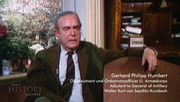Germany 1940 ▶ KL Buchenwald Concentration Camp Konzentrationslager - Wachmannschaften Command Koch / Security Guards SS Totenkopf Command Wachverband Sturmbann V „Thüringen“ Lagerkommandant Karl Otto Koch
German History Archive ▶
https://www.youtube.com/playlist?list=PLLEtu_bvreispSTeS_m08OcY8sC26bJVN
Buchenwald concentration camp (German: KL Konzentrationslager) was a German Nazi concentration camp established on Ettersberg hill near Weimar, Germany, in July 1937, one of the first and the largest of the concentration camps on German soil, following Dachau's opening just over four years earlier. Prisoners from all over Europe and the Soviet Union—Jews, Poles and other Slavs, the mentally ill and physically-disabled from birth defects, religious and political prisoners, Roma and Sinti, Freemasons, Jehovah's Witnesses (then called Bible Students), criminals, homosexuals, and prisoners of war—worked primarily as forced labor in local armaments factories. From 1945 to 1950, the camp was used by the Soviet occupation authorities as an internment camp, known as NKVD special camp number 2. Today the remains of Buchenwald serve as a memorial and permanent exhibition and museum. The SS constructed Buchenwald concentration camp in 1937. The camp was liberated by the U.S Army on 11 April 1945. Dwight D. Eisenhower, the supreme commander of the Allied Forces, later wrote, "Nothing has ever shocked me as much as that sight." Between 1945 and 1950, it was used under Communists by the Soviet Union as an NKVD special camp for German prisoners. On January 6, 1950, the Soviet authorities handed over the Buchenwald camp to the East German Ministry of Internal Affairs. The camp was to be named KZ Ettersberg, but this was changed to Buchenwald, after the beech forest which surrounds it, since "Ettersberg" carried associations with the enlightenment writer Johann Wolfgang von Goethe (1749–1832), an iconic figure in German culture. He lived in nearby Weimar and took walks through the woods in the area. According to modern folklore, he wrote some of his works under the so-called Goethe Oak, the only tree on the site to survive the construction of the camp. However, the Buchenwald and Mittelbau-Dora Memorials Foundation say that the name 'Goethe Oak' was simply an epithet made up by the inmates of the camp in commemoration of Goethe. The tree was destroyed by allied bombing in 1944. Written in the camp's main entrance gate is the motto “Jedem das Seine“ (English:To each his own). The SS intrepreted this to mean the 'superior race' had a right to humiliate and destroy others. It is embedded in the metal gate so that it can be read properly from inside the camp, rather than when standing outside. Between April 1938 and April 1945, some 238,380 people of various nationalities including 350 Western Allied prisoners of war (POW)s were incarcerated in Buchenwald. Wachsmann and the Buchenwald and Mittelbau-Dora Memorials Foundation place the number of deaths at 56,000, not including all those prisoners who died in another Camp after having overcome the death march from Buchenwald. During an American bombing raid on August 24, 1944 that was directed at a nearby armaments factory, several bombs, including incendiaries, also fell on the camp, resulting in heavy casualties among prisoners (2,000 prisoners wounded and 388 killed by the raid). Today the remains of the camp serve as a memorial and permanent exhibition and museum administered by the Buchenwald and Mittelbau-Dora Memorials Foundation, which also oversees the camp's memorial at Mittelbau-Dora.
Wachtrupp SS Totenkopf Ilse Karl Otto Koch World War Weltkrieg Holocaust Shoah Nazi Ilse Koch Die Hexe von Buchenwald KZ Konzentrationslager Concentration Camp World War 2 II Google Youtube Video simple history

1:55

3:38

5:13

1:48

2:08

2:03

4:51